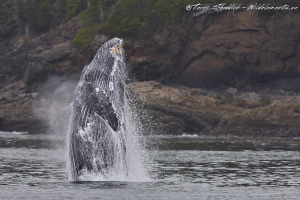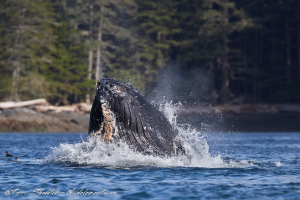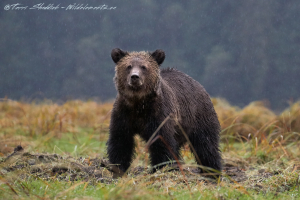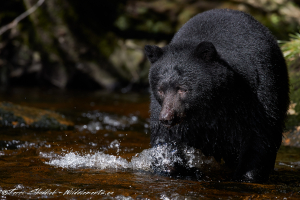20 Oct 1D X Mark II – Putting it to the Test
Notice: Trying to access array offset on value of type bool in /var/www/wp-content/plugins/bridge-core/modules/shortcodes/shortcode-elements/_social-share/templates/social-share.php on line 124
I have had my Canon EOS 1D X Mark II for about 4 months now, and in that time I have been really busy travelling and really putting the camera to the test, under my “normal” shooting conditions. If it’s not obvious from my images, I focus mostly on wildlife photography, and am often shooting hand-held, sometimes from a zodiac, like on the Marine Mammals and Great Bear Rainforest trips. I often find myself shooting in low-light conditions, from the mid-day overcast in the Great Bear Rainforest, or shooting early morning before the sun is up in the Fishing Grizzlies of the Taku. Overall, I will say that I am extremely happy with the camera, and have not had one second of buyers remorse, even with he hefty price tag of the camera.
Being an owner of the Canon EOS 1D X, my main concern was whether it was enough of an upgrade over my current camera for the price, and I have heard other 1DX owners ask the same question (it’s not like we are talking a $500 upgrade).
So after four months of testing it under my shooting conditions, here are the main things I have noticed (compared to the 1D X):
– Auto-focus is improved
– ISO performance is better
– More frames per second
– Overall better dynamic & tonal range
Autofocus Improvement:
One of the reasons why you would choose to get a flagship camera, like the 1D X Mark II, over the other cameras in the line up is to get a “faster camera”. But fast to me isn’t just defined as the frames per second, it is also defined as the speed of the autofocus. But the question I had before owning this camera is how much faster is the autofocus over the 1D X, especially given that both cameras have a 61-point AF system.
According to the specifications that were available prior to the camera being released, even though both cameras have a 61-point AF system, you would expect that it would have improved autofocus over the 1D X, because Canon improved the RGB+IR sensor from 100,000 pixels to 360,000 pixels, which is a very
large improvement. This is the sensor which is used for autofocus, you would expect that it could focus over three times faster or better.
I will say that it is definitely faster, is it three times faster, I don’t really think so, but still faster. It’s hard to quantify how it’s “faster” because it’s not like if is something that you can really measure. However, when you are faced with the quick action of a Humpback Whale breaching, or a bird flying sporadically, it feels like the 1D X Mark II acquires focus quicker. This “feeling” that it was better was re-enforced as I have reviewed images from my recent trips, and having less culling to do, especially with action shots.
Another benefit of the improved sensor is the ability to focus in lower light with a one-stop improvement on AF to EV -3 over the 1D X. While this is an improvement over the predecessor, the question is whether you are going to be in the scenario where you will actually notice the difference and get a useable image (given ISO and shutter speed restrictions). It should be noted that the EV -3 is only on single shot mode and centre point focusing, which isn’t often a scenario I find myself in. However, even when not shooting at EV -3, I have found that shooting while it is darker, I am able to get focused on the subject quite a bit quicker than I am with the 1DX.
Another feature that is now available on the 1D X Mark II is that all AF points are f/8 compatible. This means that I was able to add a 1.4x III extender to my 100-400 or a 2x extender to my 500mm lens and not be limited to the centre AF point, and I was actually pretty surprised by the results. The Lunge Feeding
image that was photographed during the Marine Mammals trip was actually photographed using the Canon EF 100-400 f/4.5-5.6L IS II USM + 1.4x III extender taken at a focal length of 560mm f/9 ISO 2000. I am waiting to get a loan of the 200-400 from Canon in order to compare the image quality of these two lenses, especially when the extenders are used. Also the Loving Life image of a sea otter was photographed at 1000mm using the 500mm with the 2x extender. While I can’t say that I will always be using these f/8 extender options, I think in certain scenarios it will increase my focal range options, especially when travelling and limited by weight and the number of lenses that can be brought on the trip.
Overall, I am extremely impressed with the speed and consistency of the auto focus, and the ability to add extenders, takes the camera up a notch from its predecessor.
Look for my future blog post that address all things Canon Auto-focus, not just specific to the 1D X Mark II, but across the camera bodies from 7D Mark II and up.
ISO Performance Improved:
With the Canon 1D X, I often hesitated to take it much over ISO 6400, and it wasn’t just because the noise, but I often found that the loss of color
and the loss of details was often so much that it made processing the image quite difficult.
On my first day in the Great Bear Rainforest, I stuck with ISO 6400 with the 1D X Mark II. When reviewing the images I noticed quite quickly how much detail and color was in the images, and how manageable the noise in the images were. I immediately bumped my auto ISO limit up to ISO 12800 on the 1D X Mark II, and I was not sorry by that decision. Looking at images from the Great Bear Rainforest at ISO 12800 using the 1D X Mark II are very useable images, and I think in some scenes they are even better detail and color as what was available on 1D X images at ISO 6400.
Not only was this Rooting in the Rain shot at ISO 12,800 with the 1D X Mark II, it was photographed in the pouring rain. I was extremely impressed with the detail on the face of the Grizzly Cub, along with the color that was still in the image.
More Frames per Second:
This heading speaks for itself, and I’ve discussed this on my blog previously. The 1D X Mark II boasts up to 16 frames per second (if using Live View) and 14 frames per second of continuous shooting. This is compared to the 12 frames per second of the 1D X. While it was easy to determine based on specs that the camera was faster, what was harder to determine was how this camera would buffer versus the predecessor.
With the increased megapixels, from 18 to 20, I expected to see an increased file size, so I was concerned how the increased file size would impact the buffer as well. With the 1D X under my normal shooting conditions, and shooting RAW images,I could get approximately 35 shots before the camera started to buffer out. With the 1D X Mark II, Canon introduced the CFAST card slot (in addition to the standard CF slot), with this I am now able to get over 100 RAW images before the camera buffers. On my recents trips this has meant that I was able to catch a breaching whale, or a bubble-netting humpback whale, without being selective or having to worry (or even think) about the buffer of the camera. It certainly made photographing next to Nikon shooters less nauseating 😃.
Overall Better Dynamic & Tonal Range:
The improved dynamic range of this camera could have been was partially discussed in the ISO improvement section, however I think it is enough of an improvement that it requires a heading of its own. Tonal Range is defined as the range of tones in an image between black and whites. Whereas, the dynamic range is defined as the blacks and whites within the image, and the better the sensor, the better the camera’s ability to capture both the shadows and highlights within a single image, without blowing out the highlights or creating a black blob of the blacks in the images. While some graphs I have seen show that the 1D X Mark II is either in-line or slightly below the 1D X for the tonal range and dynamic range at high ISO, my findings have been different (maybe the dynamic range on my 1D X wasn’t what it should have been).
The Great Bear Rainforest was the perfect opportunity to assess the dynamic range of the 1D X Mark II, because we had the opportunity to photograph both black bears and sprit (white) bears on this years trip. I am finding that images require less white balance and color adjustments on the 1D X Mark II compared
to those images of the predecessor, and I also find that images are coming out looking more as “seen in the field” with the 1D X Mark II. While I don’t do the same systematic testing as done by some of the popular sites, my thoughts are based on images that I have produced with both cameras, while shooting in my “real world shooting conditions” and not tested in a studio with consistent light and off a tripod.
Conclusion:
I have purchased many pieces of equipment over the years, some of which I immediately regretted (for example the 5D Mark II), but this certainly isn’t one of those. I have been nothing but happy with the performance of the camera, and have noticed a significant improvement on the “in the field” use, and the image quality of the images I capture with the 1D X Mark II versus those I have captured with the 1D X (which is still an outstanding camera). Whether you decide to upgrade to the 1D X Mark II or the 1D X, I don’t think you will be disappointed in the performance of ether cameras.
I have had my Canon EOS 1D X Mark II for about 4 months now, and in that time I have been really busy travelling and really putting the camera to the test, under my “normal” shooting conditions. If it’s not obvious from my images, I focus mostly on wildlife photography, and am often shooting hand-held, sometimes from a zodiac, like on the Marine Mammals and Great Bear Rainforest trips. I often find myself shooting in low-light conditions, from the mid-day overcast in the Great Bear Rainforest, or shooting early morning before the sun is up in the Fishing Grizzlies of the Taku. Overall, I will say that I am extremely happy with the camera, and have not had one second of buyers remorse, even with he hefty price tag of the camera.
Being an owner of the Canon EOS 1D X, my main concern was whether it was enough of an upgrade over my current camera for the price, and I have heard other 1DX owners ask the same question (it’s not like we are talking a $500 upgrade).
So after four months of testing it under my shooting conditions, here are the main things I have noticed (compared to the 1D X):
– Auto-focus is improved
– ISO performance is better
– More frames per second
– Overall better dynamic & tonal range
Autofocus Improvement:
One of the reasons why you would choose to get a flagship camera, like the 1D X Mark II, over the other cameras in the line up is to get a “faster camera”. But fast to me isn’t just defined as the frames per second, it is also defined as the speed of the autofocus. But the question I had before owning this camera is how much faster is the autofocus over the 1D X, especially given that both cameras have a 61-point AF system.
According to the specifications that were available prior to the camera being released, even though both cameras have a 61-point AF system, you would expect that it would have improved autofocus over the 1D X, because Canon improved the RGB+IR sensor from 100,000 pixels to 360,000 pixels, which is a very
large improvement. This is the sensor which is used for autofocus, you would expect that it could focus over three times faster or better.
I will say that it is definitely faster, is it three times faster, I don’t really think so, but still faster. It’s hard to quantify how it’s “faster” because it’s not like if is something that you can really measure. However, when you are faced with the quick action of a Humpback Whale breaching, or a bird flying sporadically, it feels like the 1D X Mark II acquires focus quicker. This “feeling” that it was better was re-enforced as I have reviewed images from my recent trips, and having less culling to do, especially with action shots.
Another benefit of the improved sensor is the ability to focus in lower light with a one-stop improvement on AF to EV -3 over the 1D X. While this is an improvement over the predecessor, the question is whether you are going to be in the scenario where you will actually notice the difference and get a useable image (given ISO and shutter speed restrictions). It should be noted that the EV -3 is only on single shot mode and centre point focusing, which isn’t often a scenario I find myself in. However, even when not shooting at EV -3, I have found that shooting while it is darker, I am able to get focused on the subject quite a bit quicker than I am with the 1DX.
Another feature that is now available on the 1D X Mark II is that all AF points are f/8 compatible. This means that I was able to add a 1.4x III extender to my 100-400 or a 2x extender to my 500mm lens and not be limited to the centre AF point, and I was actually pretty surprised by the results. The Lunge Feeding
image that was photographed during the Marine Mammals trip was actually photographed using the Canon EF 100-400 f/4.5-5.6L IS II USM + 1.4x III extender taken at a focal length of 560mm f/9 ISO 2000. I am waiting to get a loan of the 200-400 from Canon in order to compare the image quality of these two lenses, especially when the extenders are used. Also the Loving Life image of a sea otter was photographed at 1000mm using the 500mm with the 2x extender. While I can’t say that I will always be using these f/8 extender options, I think in certain scenarios it will increase my focal range options, especially when travelling and limited by weight and the number of lenses that can be brought on the trip.
Overall, I am extremely impressed with the speed and consistency of the auto focus, and the ability to add extenders, takes the camera up a notch from its predecessor.
Look for my future blog post that address all things Canon Auto-focus, not just specific to the 1D X Mark II, but across the camera bodies from 7D Mark II and up.
ISO Performance Improved:
With the Canon 1D X, I often hesitated to take it much over ISO 6400, and it wasn’t just because the noise, but I often found that the loss of color
and the loss of details was often so much that it made processing the image quite difficult.
On my first day in the Great Bear Rainforest, I stuck with ISO 6400 with the 1D X Mark II. When reviewing the images I noticed quite quickly how much detail and color was in the images, and how manageable the noise in the images were. I immediately bumped my auto ISO limit up to ISO 12800 on the 1D X Mark II, and I was not sorry by that decision. Looking at images from the Great Bear Rainforest at ISO 12800 using the 1D X Mark II are very useable images, and I think in some scenes they are even better detail and color as what was available on 1D X images at ISO 6400.
Not only was this Rooting in the Rain shot at ISO 12,800 with the 1D X Mark II, it was photographed in the pouring rain. I was extremely impressed with the detail on the face of the Grizzly Cub, along with the color that was still in the image.
More Frames per Second:
This heading speaks for itself, and I’ve discussed this on my blog previously. The 1D X Mark II boasts up to 16 frames per second (if using Live View) and 14 frames per second of continuous shooting. This is compared to the 12 frames per second of the 1D X. While it was easy to determine based on specs that the camera was faster, what was harder to determine was how this camera would buffer versus the predecessor.
With the increased megapixels, from 18 to 20, I expected to see an increased file size, so I was concerned how the increased file size would impact the buffer as well. With the 1D X under my normal shooting conditions, and shooting RAW images,I could get approximately 35 shots before the camera started to buffer out. With the 1D X Mark II, Canon introduced the CFAST card slot (in addition to the standard CF slot), with this I am now able to get over 100 RAW images before the camera buffers. On my recents trips this has meant that I was able to catch a breaching whale, or a bubble-netting humpback whale, without being selective or having to worry (or even think) about the buffer of the camera. It certainly made photographing next to Nikon shooters less nauseating 😃.
Overall Better Dynamic & Tonal Range:
The improved dynamic range of this camera could have been was partially discussed in the ISO improvement section, however I think it is enough of an improvement that it requires a heading of its own. Tonal Range is defined as the range of tones in an image between black and whites. Whereas, the dynamic range is defined as the blacks and whites within the image, and the better the sensor, the better the camera’s ability to capture both the shadows and highlights within a single image, without blowing out the highlights or creating a black blob of the blacks in the images. While some graphs I have seen show that the 1D X Mark II is either in-line or slightly below the 1D X for the tonal range and dynamic range at high ISO, my findings have been different (maybe the dynamic range on my 1D X wasn’t what it should have been).
The Great Bear Rainforest was the perfect opportunity to assess the dynamic range of the 1D X Mark II, because we had the opportunity to photograph both black bears and sprit (white) bears on this years trip. I am finding that images require less white balance and color adjustments on the 1D X Mark II compared
to those images of the predecessor, and I also find that images are coming out looking more as “seen in the field” with the 1D X Mark II. While I don’t do the same systematic testing as done by some of the popular sites, my thoughts are based on images that I have produced with both cameras, while shooting in my “real world shooting conditions” and not tested in a studio with consistent light and off a tripod.
Conclusion:
I have purchased many pieces of equipment over the years, some of which I immediately regretted (for example the 5D Mark II), but this certainly isn’t one of those. I have been nothing but happy with the performance of the camera, and have noticed a significant improvement on the “in the field” use, and the image quality of the images I capture with the 1D X Mark II versus those I have captured with the 1D X (which is still an outstanding camera). Whether you decide to upgrade to the 1D X Mark II or the 1D X, I don’t think you will be disappointed in the performance of ether cameras.
Notice: Trying to access array offset on value of type bool in /var/www/wp-content/plugins/bridge-core/modules/shortcodes/shortcode-elements/_social-share-list/templates/social-share-list.php on line 104








